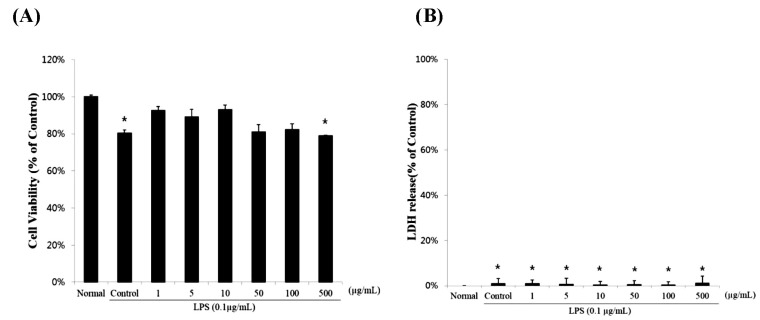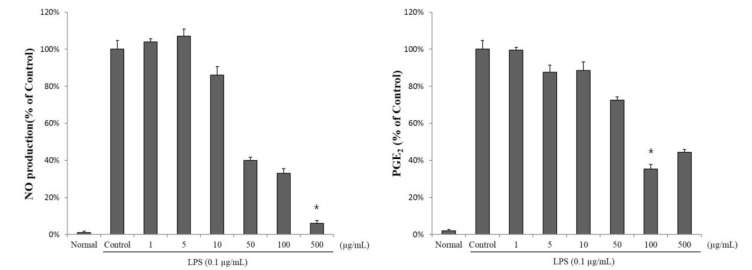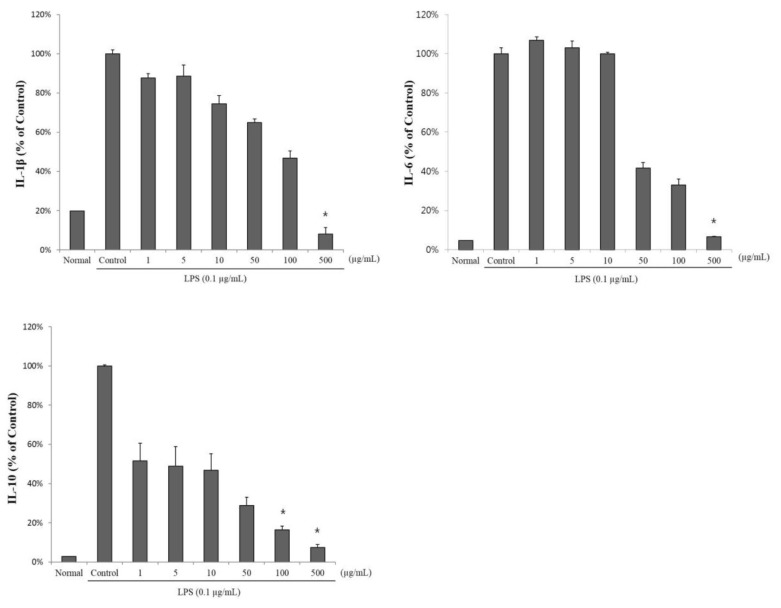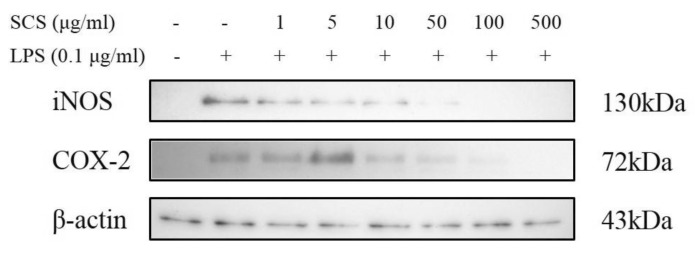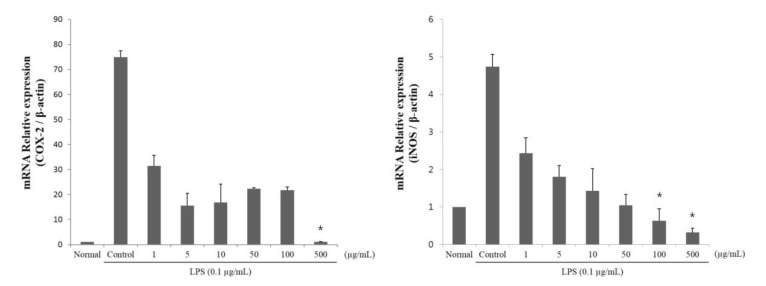Korean J Physiol Pharmacol.
2014 Feb;18(1):33-39. 10.4196/kjpp.2014.18.1.33.
Anti-Inflammatory and Anti-Superbacterial Properties of Sulforaphane from Shepherd's Purse
- Affiliations
-
- 1Department of Microbiology, College of Medicine, Chung-Ang University, Seoul 156-861, Korea. kimwy@cau.ac.kr
- 2College of Pharmacy, Chung-Ang University, Seoul 156-861, Korea.
- KMID: 2285488
- DOI: http://doi.org/10.4196/kjpp.2014.18.1.33
Abstract
- Shepherd's purse, Capsella bursa-pastoris (L.) Medik., has been considered a health food for centuries in Asia and is known to contain the isothiocyanate compound sulforaphane. In this study, we evaluated the anti-inflammatory and antibacterial properties of a sulforaphane-containing solution (SCS) isolated from shepherd's purse. SCS had significant anti-inflammatory activity indicated by the decreased levels of nitric oxide (NO), cytokines (interleukin 1beta [IL-1beta], IL-6, and IL-10), and prostaglandin E2 (PGE2) in lipopolysaccharide-stimulated RAW 264.7 murine macrophages. In addition, SCS decreased the inducible NO synthase (iNOS) and cyclooxygenase 2 (COX-2) levels, which confirmed the anti-inflammatory activity of SCS. Further, SCS inhibited vancomycin-resistant enterococci (VRE) and Bacillus anthracis. The minimal inhibitory concentration was 250 microg/ml for VRE and 1,000 microg/ml for B. anthracis. Taken together, these data indicate that SCS has potential anti-inflammatory and anti-superbacterial properties, and thus it can be used as a functional food or pharmaceutical.
Keyword
MeSH Terms
Figure
Cited by 1 articles
-
Effect of Vitamin E Supplementation on Intestinal Barrier Function in Rats Exposed to High Altitude Hypoxia Environment
Chunlan Xu, Rui Sun, Xiangjin Qiao, Cuicui Xu, Xiaoya Shang, Weining Niu, Yu Chao
Korean J Physiol Pharmacol. 2014;18(4):313-320. doi: 10.4196/kjpp.2014.18.4.313.
Reference
-
1. Koch MA, Kiefer M. Genome evolution among cruciferous plants: a lecture from the comparison of the genetic maps of three diploid species--Capsella rubella, Arabidopsis lyrata subsp. petraea, and A. thaliana. Am J Bot. 2005; 92:761–767. PMID: 21652456.
Article2. Hurka H, Bleeker W, Neuffer B. Evolutionary processes associated with biological invasions in the brassicaceae. Biol Invasions. 2003; 5:281–292.
Article3. Kim H, Song MJ, Potter D. Medicinal efficacy of plants utilized as temple food in traditional Korean Buddhism. J Ethnopharmacol. 2006; 104:32–46. PMID: 16216457.
Article4. Zhou W. Ethnobotany of Capsella bursa-pastoris (L.) Medic. J Plant Resour Environ. 1998; 7:49–53.5. Conaway CC, Wang CX, Pittman B, Yang YM, Schwartz JE, Tian D, McIntee EJ, Hecht SS, Chung FL. Phenethyl isothiocyanate and sulforaphane and their N-acetylcysteine conjugates inhibit malignant progression of lung adenomas induced by tobacco carcinogens in A/J mice. Cancer Res. 2005; 65:8548–8557. PMID: 16166336.
Article6. Fahey JW, Zhang Y, Talalay P. Broccoli sprouts: an exceptionally rich source of inducers of enzymes that protect against chemical carcinogens. Proc Natl Acad Sci U S A. 1997; 94:10367–10372. PMID: 9294217.
Article7. Fahey JW, Haristoy X, Dolan PM, Kensler TW, Scholtus I, Stephenson KK, Talalay P, Lozniewski A. Sulforaphane inhibits extracellular, intracellular, and antibiotic-resistant strains of Helicobacter pylori and prevents benzo[a]pyrene-induced stomach tumors. Proc Natl Acad Sci U S A. 2002; 99:7610–7615. PMID: 12032331.
Article8. Zhang Y, Kensler TW, Cho CG, Posner GH, Talalay P. Anticarcinogenic activities of sulforaphane and structurally related synthetic norbornyl isothiocyanates. Proc Natl Acad Sci U S A. 1994; 91:3147–3150. PMID: 8159717.
Article9. Chung FL, Conaway CC, Rao CV, Reddy BS. Chemoprevention of colonic aberrant crypt foci in Fischer rats by sulforaphane and phenethyl isothiocyanate. Carcinogenesis. 2000; 21:2287–2291. PMID: 11133820.
Article10. Singh AV, Xiao D, Lew KL, Dhir R, Singh SV. Sulforaphane induces caspase-mediated apoptosis in cultured PC-3 human prostate cancer cells and retards growth of PC-3 xenografts in vivo. Carcinogenesis. 2004; 25:83–90. PMID: 14514658.
Article11. Jackson SJ, Singletary KW. Sulforaphane: a naturally occurring mammary carcinoma mitotic inhibitor, which disrupts tubulin polymerization. Carcinogenesis. 2004; 25:219–227. PMID: 14578157.
Article12. Boddupalli S, Mein JR, Lakkanna S, James DR. Induction of phase 2 antioxidant enzymes by broccoli sulforaphane: perspectives in maintaining the antioxidant activity of vitamins a, C, and e. Front Genet. 2012; 3:7. PMID: 22303412.
Article13. Defelice MS. Shepherd's-purse, Capsella bursa-pastoris (L.) Medic. Weed Technol. 2001; 15:892–895.14. Zennie TM, Ogzewalla D. Ascorbic acid and Vitamin A content of edible wild plants of Ohio and Kentucky. Economic Botany. 1977; 31:76–79.
Article15. Kweon MH, Kwak JH, Ra KS, Sung HC, Yang HC. Structural characterization of a flavonoid compound scavenging superoxide anion radical isolated from capsella bursa - pastoris. J Biochem Mol Biol. 1996; 29:423–428.16. Song N, Xu W, Guan H, Liu X, Wang Y, Nie X. Several flavonoids from Capsella bursa-pastoris (L.) Medic. Asian J Trad Med. 2007; 2:218–222.17. Brock A, Herzfeld T, Paschke R, Koch M, Dräger B. Brassicaceae contain nortropane alkaloids. Phytochemistry. 2006; 67:2050–2057. PMID: 16884746.
Article18. Cole PA. Association of canine splenic hemangiosarcomas and hematomas with nodular lymphoid hyperplasia or siderotic nodules. J Vet Diagn Invest. 2012; 24:759–762. PMID: 22621950.
Article19. Marquina JMG, Villa MG, Garriga AB. Fracción saponínica de la "Capsella bursa pastoris". An R Acad Nac Farmac. 1955; 21:49–60.20. Boscá L, Zeini M, Través PG, Hortelano S. Nitric oxide and cell viability in inflammatory cells: a role for NO in macrophage function and fate. Toxicology. 2005; 208:249–258. PMID: 15691589.
Article21. Lawrence T, Willoughby DA, Gilroy DW. Anti-inflammatory lipid mediators and insights into the resolution of inflammation. Nat Rev Immunol. 2002; 2:787–795. PMID: 12360216.
Article22. Kaplanski G, Marin V, Montero-Julian F, Mantovani A, Farnarier C. IL-6: a regulator of the transition from neutrophil to monocyte recruitment during inflammation. Trends Immunol. 2003; 24:25–29. PMID: 12495721.
Article23. Ware CF. Network communications: lymphotoxins, LIGHT, and TNF. Annu Rev Immunol. 2005; 23:787–819. PMID: 15771586.
Article24. Harris SG, Padilla J, Koumas L, Ray D, Phipps RP. Prostaglandins as modulators of immunity. Trends Immunol. 2002; 23:144–150. PMID: 11864843.
Article25. Bogdan C. Nitric oxide and the immune response. Nat Immunol. 2001; 2:907–916. PMID: 11577346.
Article26. Wu G, Morris SM Jr. Arginine metabolism: nitric oxide and beyond. Biochem J. 1998; 336:1–17. PMID: 9806879.
Article27. Moellering RC Jr. Vancomycin-resistant enterococci. Clin Infect Dis. 1998; 26:1196–1199. PMID: 9597252.
Article28. Boucher HW, Talbot GH, Bradley JS, Edwards JE, Gilbert D, Rice LB, Scheld M, Spellberg B, Bartlett J. Bad bugs, no drugs: no ESKAPE! An update from the Infectious Diseases Society of America. Clin Infect Dis. 2009; 48:1–12. PMID: 19035777.
Article29. Horiuchi K, Shiota S, Hatano T, Yoshida T, Kuroda T, Tsuchiya T. Antimicrobial activity of oleanolic acid from Salvia officinalis and related compounds on vancomycin-resistant enterococci (VRE). Biol Pharm Bull. 2007; 30:1147–1149. PMID: 17541170.
Article30. Inglesby TV, Henderson DA, Bartlett JG, Ascher MS, Eitzen E, Friedlander AM, Hauer J, McDade J, Osterholm MT, O'Toole T, Parker G, Perl TM, Russell PK, Tonat K. Working Group on Civilian Biodefense. Anthrax as a biological weapon: medical and public health management. JAMA. 1999; 281:1735–1745. PMID: 10328075.31. Matusheski NV, Wallig MA, Juvik JA, Klein BP, Kushad MM, Jeffery EH. Preparative HPLC method for the purification of sulforaphane and sulforaphane nitrile from Brassica oleracea. J Agric Food Chem. 2001; 49:1867–1872. PMID: 11308338.
Article32. Pan MH, Lai CS, Wang YJ, Ho CT. Acacetin suppressed LPS-induced up-expression of iNOS and COX-2 in murine macrophages and TPA-induced tumor promotion in mice. Biochem Pharmacol. 2006; 72:1293–1303. PMID: 16949556.
Article33. Kim SJ. Curcumin suppresses the production of interleukin-6 in Prevotella intermedia lipopolysaccharide-activated RAW 264.7 cells. J Periodontal Implant Sci. 2011; 41:157–163. PMID: 21811692.34. Hong JI, Ra KS, Yang HC. Free radical scavenging and antioxidative activities by ethanol extract from Capsella bursa-pastoris. Korean J Food Nutr. 1994; 7:169–176.35. Goun EA, Petrichenko VM, Solodnikov SU, Suhinina TV, Kline MA, Cunningham G, Nguyen C, Miles H. Anticancer and antithrombin activity of Russian plants. J Ethnopharmacol. 2002; 81:337–342. PMID: 12127234.
Article36. Park CJ, Park CB, Hong SS, Lee HS, Lee SY, Kim SC. Characterization and cDNA cloning of two glycine- and histidine-rich antimicrobial peptides from the roots of shepherd's purse, Capsella bursa-pastoris. Plant Mol Biol. 2000; 44:187–197. PMID: 11117262.37. Ivanova D, Gerova D, Chervenkov T, Yankova T. Polyphenols and antioxidant capacity of Bulgarian medicinal plants. J Ethnopharmacol. 2005; 96:145–150. PMID: 15588663.
Article38. Kuroda K, Akao M, Kanisawa M, Miyaki K. Inhibitory effect of Capsella bursa-pastoris extract on growth of Ehrlich solid tumor in mice. Cancer Res. 1976; 36:1900–1903. PMID: 1268843.39. Li Y, Zhang T, Korkaya H, Liu S, Lee HF, Newman B, Yu Y, Clouthier SG, Schwartz SJ, Wicha MS, Sun D. Sulforaphane, a dietary component of broccoli/broccoli sprouts, inhibits breast cancer stem cells. Clin Cancer Res. 2010; 16:2580–2590. PMID: 20388854.
Article40. Lianga H, Yuana QP, Dong HR, Liu YM. Determination of sulforaphane in broccoli and cabbage by high-performance liquid chromatography. J Food Compos Anal. 2006; 19:473–476.41. Baek SH, Park M, Suh JH, Choi HS. Protective effects of an extract of young radish (Raphanus sativus L) cultivated with sulfur (sulfur-radish extract) and of sulforaphane on carbon tetrachloride-induced hepatotoxicity. Biosci Biotechnol Biochem. 2008; 72:1176–1182. PMID: 18460814.
Article42. Ishiguro Y. Mucosal proinflammatory cytokine production correlates with endoscopic activity of ulcerative colitis. J Gastroenterol. 1999; 34:66–74. PMID: 10204613.
Article43. Kawasaki T, Fujimi S, Lederer JA, Hubbard WJ, Choudhry MA, Schwacha MG, Bland KI, Chaudry IH. Trauma-hemorrhage induces depressed splenic dendritic cell functions in mice. J Immunol. 2006; 177:4514–4520. PMID: 16982888.
Article44. Klotz L, Schmidt M, Giese T, Sastre M, Knolle P, Klockgether T, Heneka MT. Proinflammatory stimulation and pioglitazone treatment regulate peroxisome proliferator-activated receptor gamma levels in peripheral blood mononuclear cells from healthy controls and multiple sclerosis patients. J Immunol. 2005; 175:4948–4955. PMID: 16210596.45. Calder PC. n-3 polyunsaturated fatty acids, inflammation, and inflammatory diseases. Am J Clin Nutr. 2006; 83(6 Suppl):1505S–1519S. PMID: 16841861.
Article46. Agirbasli M, Inanc N, Baykan OA, Direskeneli H. The effects of TNF alpha inhibition on plasma fibrinolytic balance in patients with chronic inflammatory rheumatical disorders. Clin Exp Rheumatol. 2006; 24:580–583. PMID: 17181930.47. Bora NS, Sohn JH, Bora PS, Kaplan HJ, Kulkarni P. Anti-inflammatory effects of specific cyclooxygenase 2,5-lipoxygenase, and inducible nitric oxide synthase inhibitors on experimental autoimmune anterior uveitis (EAAU). Ocul Immunol Inflamm. 2005; 13:183–189. PMID: 16019677.
Article48. Dugo L, Marzocco S, Mazzon E, Di Paola R, Genovese T, Caputi AP, Cuzzocrea S. Effects of GW274150, a novel and selective inhibitor of iNOS activity, in acute lung inflammation. Br J Pharmacol. 2004; 141:979–987. PMID: 14769784.
Article49. Medeiros AI, Sá-Nunes A, Soares EG, Peres CM, Silva CL, Faccioli LH. Blockade of endogenous leukotrienes exacerbates pulmonary histoplasmosis. Infect Immun. 2004; 72:1637–1644. PMID: 14977971.
Article50. Skupień K, Oszmiański J, Kostrzewa-Nowak D, Tarasiuk J. In vitro antileukaemic activity of extracts from berry plant leaves against sensitive and multidrug resistant HL60 cells. Cancer Lett. 2006; 236:282–291. PMID: 16039042.
Article51. Sood S, Malhotra M, Das BK, Kapil A. Enterococcal infections & antimicrobial resistance. Indian J Med Res. 2008; 128:111–121. PMID: 19001673.52. Fahey JW, Haristoy X, Dolan PM, Kensler TW, Scholtus I, Stephenson KK, Talalay P, Lozniewski A. Sulforaphane inhibits extracellular, intracellular, and antibiotic-resistant strains of Helicobacter pylori and prevents benzo[a]pyrene-induced stomach tumors. Proc Natl Acad Sci U S A. 2002; 99:7610–7615. PMID: 12032331.
Article
- Full Text Links
- Actions
-
Cited
- CITED
-
- Close
- Share
- Similar articles
-
- Occurrence of Clubroot on Shepherd's-purse Caused by Plasmodiophora brassicae
- Anti-Inflammatory and Anti-Superbacterial Activity of Polyphenols Isolated from Black Raspberry
- Isolation of Quercetin and Isorhamnetin Derivatives and Evaluation of Anti-microbial and Anti-inflammatory Activities of Persicaria glabra
- Anti-inflammatory effect of sulforaphane on LPS-stimulated RAW 264.7 cells and ob/ob mice
- Anti-Inflammatory Effect of Phlorotannin on Chronic Nonbacterial Prostatitis in a Rat Model

